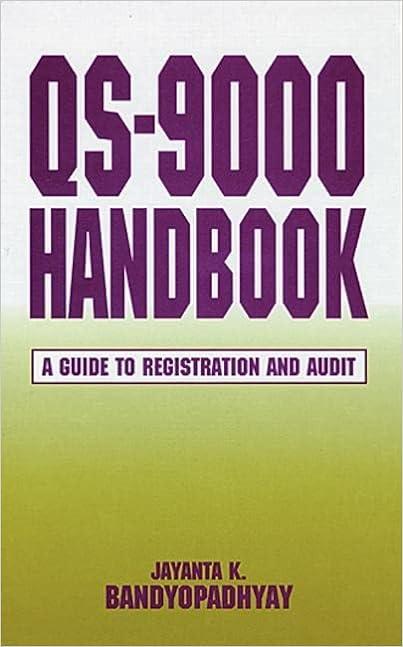Question
Direct Materials Under normal conditions, Sarah spends $8.40 per unit of materials, and it will take 3.60 units of material per pair of shoes. During
Direct Materials
Under normal conditions, Sarah spends $8.40 per unit of materials, and it will take 3.60 units of material per pair of shoes. During July, Sole Purpose Shoe Company incurred actual direct materials costs of $62,211 for 6,990 units of direct materials in the production of 2,150 pairs of shoes.
Complete the following table, showing the direct materials variance relationships for July for Sole Purpose Shoe Company. If required, round your answers to two decimal places. When entering variances, use a negative number for a favorable cost variance, and a positive number for an unfavorable cost variance.
| Actual Cost | Standard Cost | |||||||||
| Actual Quantity | X | Actual Price | Actual Quantity | X | Standard Price | Standard Quantity | X | Standard Price | ||
| X | $ | X | $ | X | $ | |||||
| = $ | = $ | = $ | ||||||||
| Direct Materials Variance: | Direct Materials Variance: | |||||||||
| $ | $ | |||||||||
| Total Direct Materials Variance: | ||||||||||
| $ | ||||||||||
Direct Labor
Under normal conditions, Sarah pays her employees $8.50 per hour, and it will take 2.80 hours of labor per pair of shoes. During August, Sole Purpose Shoe Company incurred actual direct labor costs of $65,610 for 7,290 hours of direct labor in the production of 2,100 pairs of shoes.
Complete the following table, showing the direct labor variance relationships for August for Sole Purpose Shoe Company. If required, round your answers to two decimal places. When entering variances, use a negative number for a favorable variance, and a positive number for an unfavorable variance.
| Actual Cost | Standard Cost | |||||||||
| Actual Hours | X | Actual Rate | Actual Hours | X | Standard Rate | Standard Hours | X | Standard Rate | ||
| X | $ | X | $ | X | $ | |||||
| = $ | = $ | = $ | ||||||||
| Direct Labor Variance: | Direct Labor Variance: | |||||||||
| $ | $ | |||||||||
| Total Direct Labor Variance: | ||||||||||
| $ | ||||||||||
Budget Performance Report
Sarah has learned a lot from you over the past two months, and has compiled the following data for Sole Purpose Shoe Company for September using the techniques you taught her. She would like your help in preparing a Budget Performance Report for September. The company produced 2,500 pairs of shoes that required 8,750 units of material purchased at $8.20 per unit and 6,750 hours of labor at an hourly rate of $8.90 per hour during the month. Actual factory overhead during September was $20,250. When entering variances, use a negative number for a favorable cost variance, and a positive number for an unfavorable cost variance.
Use the data in the following table to prepare the Budget Performance Report for Sole Purpose Shoe Company for September.
| Manufacturing Costs | Standard Price | Standard Quantity | Standard Cost Per Unit |
| Direct materials | $8.40 per unit | 3.60 units per pair | $30.24 |
| Direct labor | $8.50 per hour | 2.80 hours per pair | 23.80 |
| Factory overhead | $2.70 per hour | 2.80 hours per pair | 7.56 |
| Total standard cost per pair | $61.60 |
| Sole Purpose Shoe Company Budget Performance Report For the Month Ended September 30 | |||
| Manufacturing Costs | Actual Costs | Standard Cost at Actual Volume | Cost Variance - (Favorable) Unfavorable |
| Direct materials | $ | $ | $ |
| Direct labor | |||
| Factory overhead | |||
| Total manufacturing costs | $ | $ | $ |
Final Questions
Before Sarah makes any changes based on the Budget Performance Report for September, she wants to be sure she understands the results, and has the following questions for you.
Answer the following questions (1) and (2). All questions pertain to the September data.
1. What caused the total cost variance for direct materials?
a. The actual quantity of direct materials per unit was less than the standard quantity.
b. The actual price for direct materials per unit was less than the standard price.
c. The favorable price variance dominated the unfavorable quantity variance, causing the total cost variance for direct materials to be favorable.
d. The unfavorable quantity variance dominated the favorable price variance, causing the total cost variance for direct materials to be unfavorable.
e. A factor other than those listed caused the total cost variance for direct materials.
2. What caused the total cost variance for direct labor?
a. The actual number of labor hours per unit was less than the standard number.
b. The unfavorable rate variance was larger than the favorable time variance, causing the total cost variance for direct labor to be unfavorable.
c. The favorable time variance was larger than the unfavorable rate variance, causing the total cost variance for direct labor to be favorable.
d. The actual rate for labor hours per unit was less than the standard rate.
e. A factor other than those listed caused the total cost variance for direct labor.
Step by Step Solution
There are 3 Steps involved in it
Step: 1

Get Instant Access to Expert-Tailored Solutions
See step-by-step solutions with expert insights and AI powered tools for academic success
Step: 2

Step: 3

Ace Your Homework with AI
Get the answers you need in no time with our AI-driven, step-by-step assistance
Get Started


